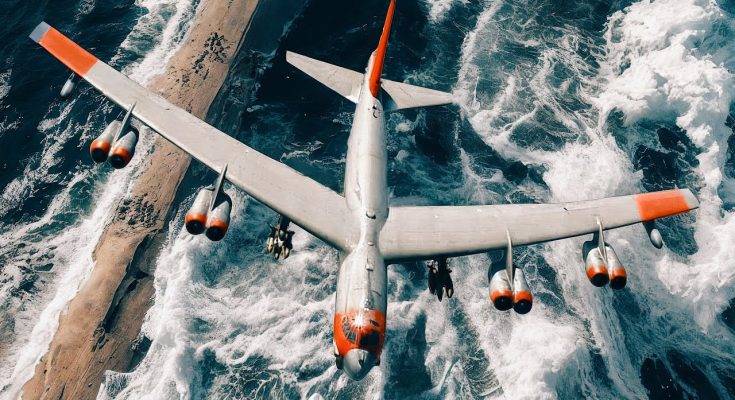The Boeing B-52 Stratofortress is one of the most iconic bombers in the world, representing a significant element of the U.S. Air Force’s strategic bombing capability. Although the aircraft has been in service for over 60 years, it remains an essential asset due to its long-range bombing capability, payload capacity, and ability to carry both nuclear and conventional weapons. The ability to respond quickly in times of crisis is critical, and when an emergency takeoff alert is issued, the B-52’s crews must act swiftly, demonstrating the discipline, efficiency, and precision necessary to get the bomber airborne in the shortest time possible.
The B-52’s Strategic Importance
The B-52 has been a central part of the U.S. Air Force’s nuclear triad since the 1950s, capable of carrying both nuclear bombs and a range of precision-guided conventional munitions. With a maximum payload capacity of 70,000 pounds and a flight range of over 8,800 miles, the B-52 is a critical tool for long-range deterrence, capable of flying anywhere in the world with its twin-engine turbofan engines. The aircraft can carry a wide variety of bombs, including JDAMs, nuclear bombs, and mines, making it highly versatile in a variety of combat scenarios.
However, in times of heightened tensions or potential conflict, the B-52 must be able to respond immediately. This is where the emergency takeoff alert comes into play.
The Emergency Takeoff Alert
An emergency takeoff alert typically occurs when the U.S. military is placed on a high readiness posture due to a potential threat. This could happen during times of international crisis, military escalation, or when nuclear deterrence is required. The B-52 is often placed on alert status at military airbases, ready to take off at a moment’s notice if required to carry out a strategic bombing mission or respond to an adversary’s threat.
In an emergency scenario, the B-52 bomber’s crew, including the pilots, flight engineers, and weapon systems officers, are pre-positioned in the aircraft, with everything set for takeoff. The alert crews undergo regular drills to ensure they can handle these scenarios with precision and speed.
The Rush to Full Speed
When the alert is sounded, the flight crew’s reaction must be almost instantaneous. The emergency takeoff sequence for the B-52 involves several key steps:
-
Rapid Boarding and Preflight Check: As soon as the alert is received, the crew rushes to the aircraft. B-52 crews are always on standby, ready to board the aircraft in seconds. Once inside, the crew performs a series of critical preflight checks to ensure that the aircraft’s systems are fully operational.
-
Engine Start-Up: In older bombers like the B-52, the engines are powered up using small explosive charges in the start-up system. This quick engine start ensures that the aircraft can begin taxiing immediately after the crew completes preflight checks.
-
Taxiing to the Runway: The aircraft, now running on all engines, taxis rapidly to the runway. The B-52’s long fuselage and large wings give it a stable platform, even during fast taxiing operations. However, its size requires careful maneuvering to avoid obstacles and other aircraft.
-
Takeoff: As the aircraft positions itself on the runway, the pilots apply full throttle, utilizing the B-52’s powerful engines to accelerate down the runway. The bomber can take off at a max takeoff weight of 488,000 pounds, requiring careful management of its engine power and control surfaces. During an emergency takeoff, full afterburners may be used to maximize thrust for a rapid climb-out.
-
Achieving Altitude and Mission Readiness: Once airborne, the B-52 climbs to its designated altitude and heads toward its target area. The aircraft’s long range and heavy payload capacity make it highly suited for long-duration flights, and with its air-to-air refueling capability, it can stay in the air for hours if necessary.
The Role of Ground Support
Getting a B-52 bomber airborne in an emergency situation is not only about the speed and efficiency of the crew but also the support from ground personnel. These include:
-
Maintenance crews who ensure the aircraft is in optimal condition.
-
Refueling personnel who can quickly provide the aircraft with fuel if needed.
-
Air traffic control at the base that ensures the bomber has a clear path to take off without delays.
These teams play an integral role in ensuring the B-52 can respond effectively during an alert.
The Importance of Readiness and Training
A rapid takeoff in response to an emergency is a well-rehearsed drill for B-52 aircrews. These crews undergo rigorous training exercises to simulate emergency scenarios, ensuring they can react quickly and accurately. The U.S. Air Force ensures that crews are constantly prepared for any eventuality, whether it’s a strategic bombing mission, defensive posture, or immediate escalation.
Moreover, the B-52’s long operational life means that its crews have a wealth of experience and knowledge to draw from when it comes to emergency procedures. This combination of technology, experience, and rapid response capabilities has kept the B-52 relevant in today’s fast-paced, high-threat environment.
Conclusion
The B-52 Stratofortress is a symbol of U.S. military power and strategic deterrence, capable of launching a devastating response in times of crisis. When an emergency takeoff alert is issued, the B-52 crews must respond quickly, working together in a highly coordinated effort to get the aircraft airborne at full speed. The B-52’s ability to rapidly launch, combined with the aircraft’s unparalleled payload capacity and long-range strike capabilities, ensures that it remains a critical asset in the U.S. Air Force’s arsenal. Whether in times of crisis or routine operations, the B-52’s crews stand ready to answer the call whenever it is needed.



